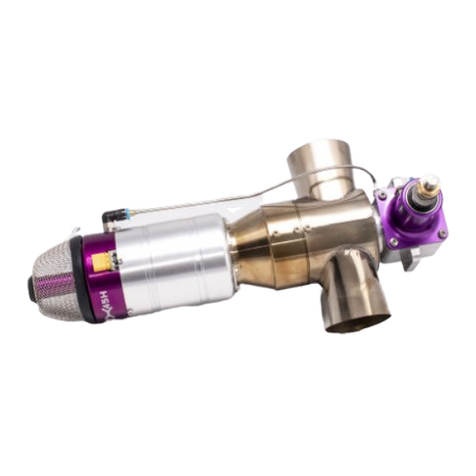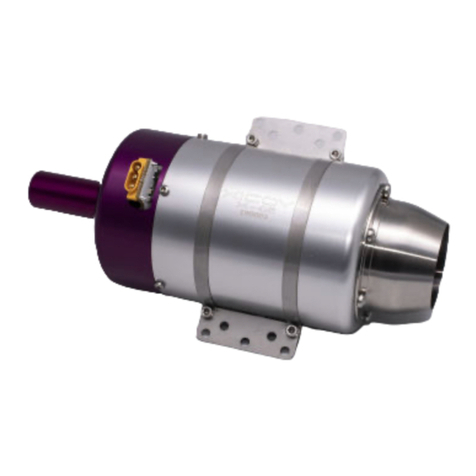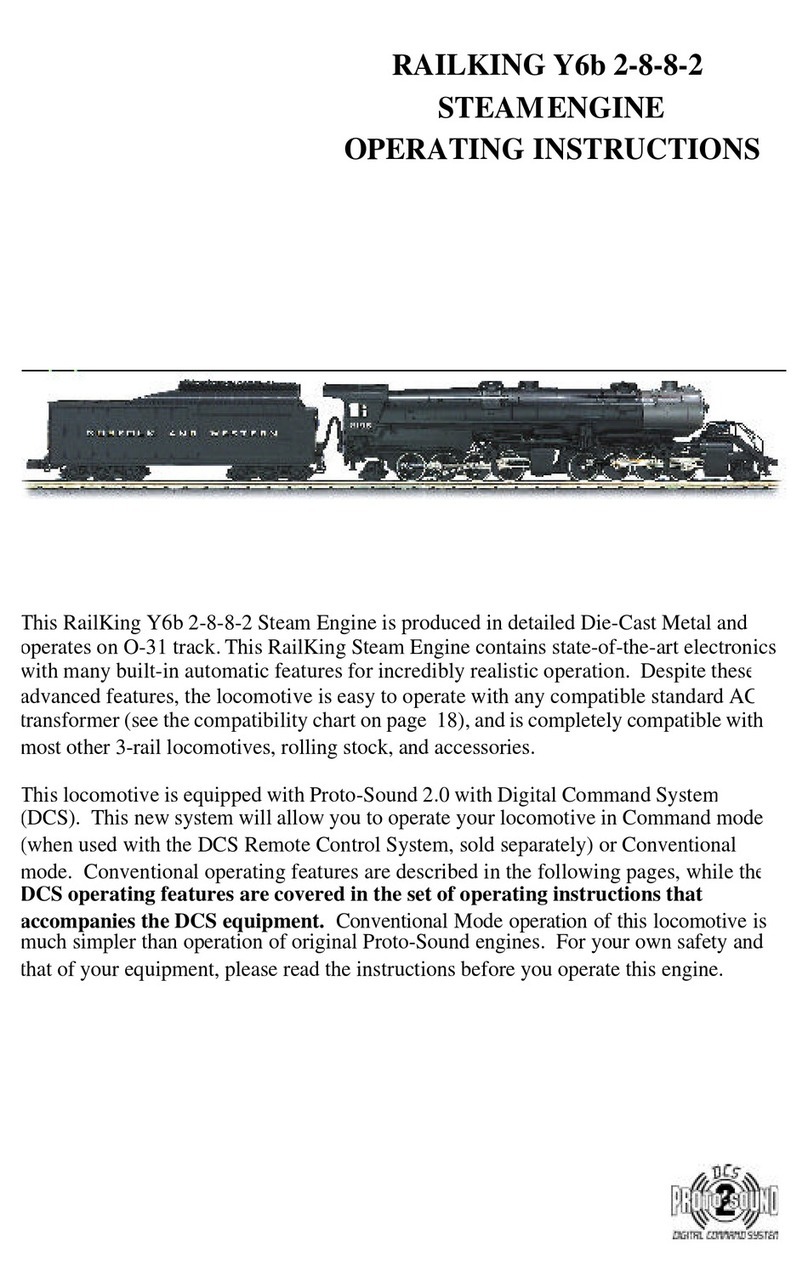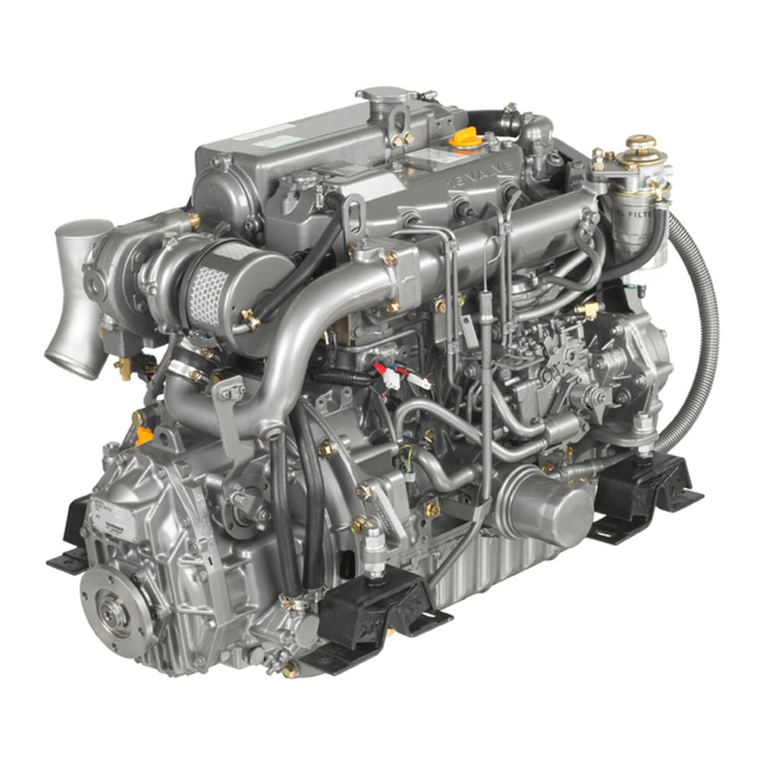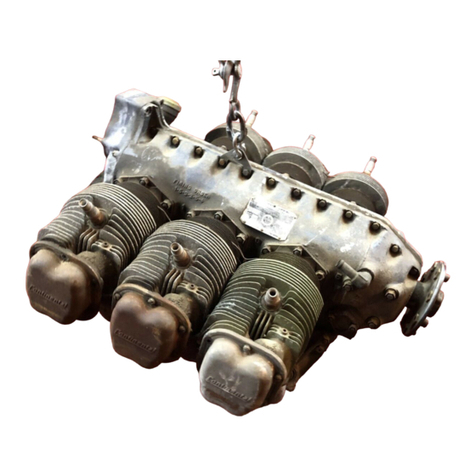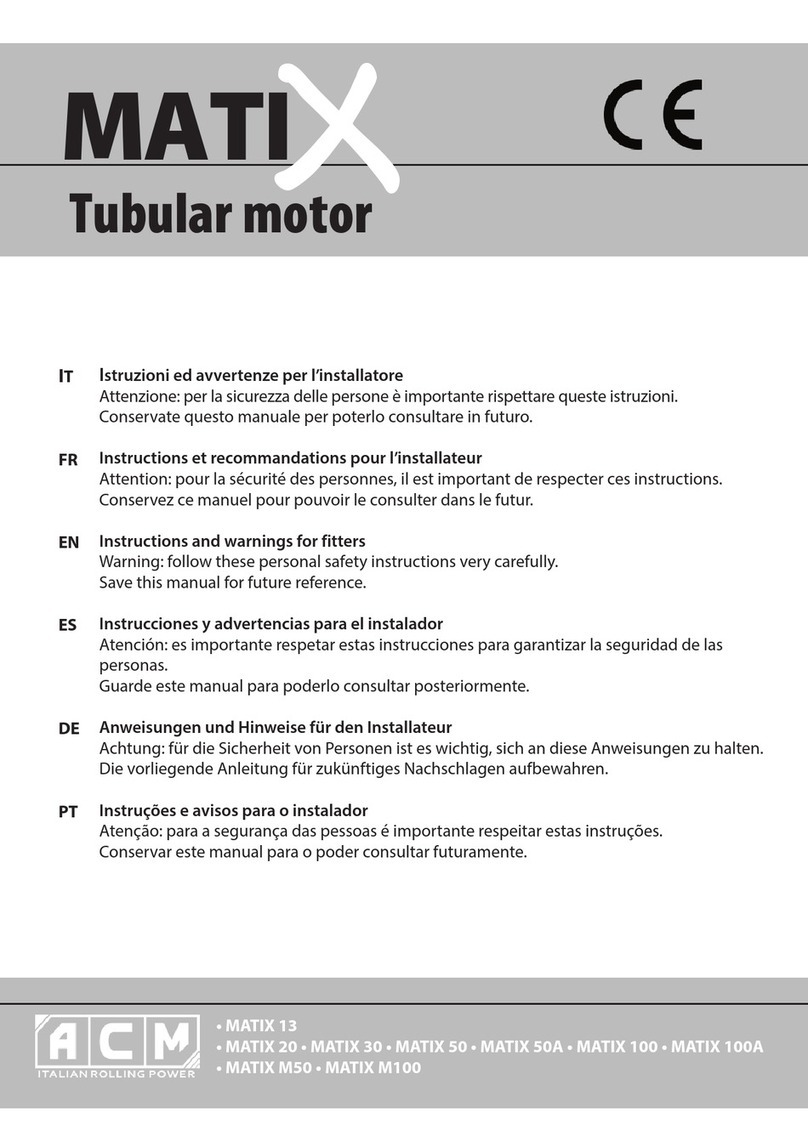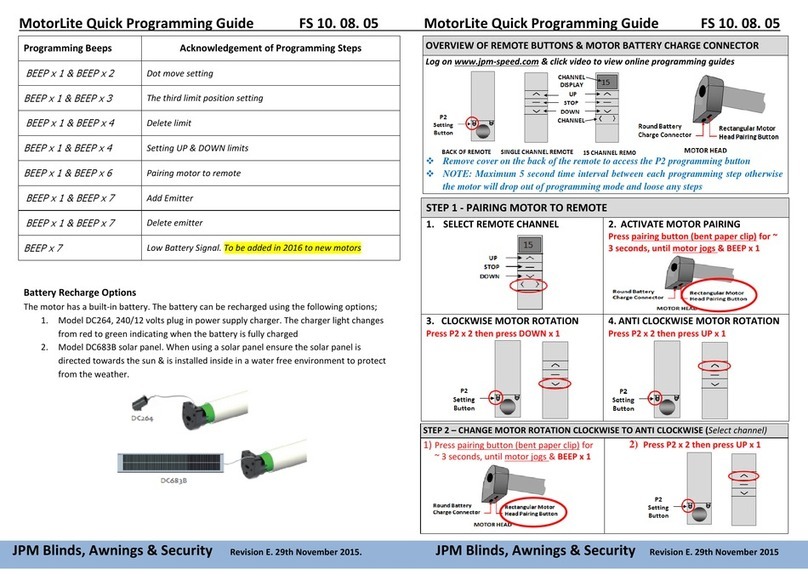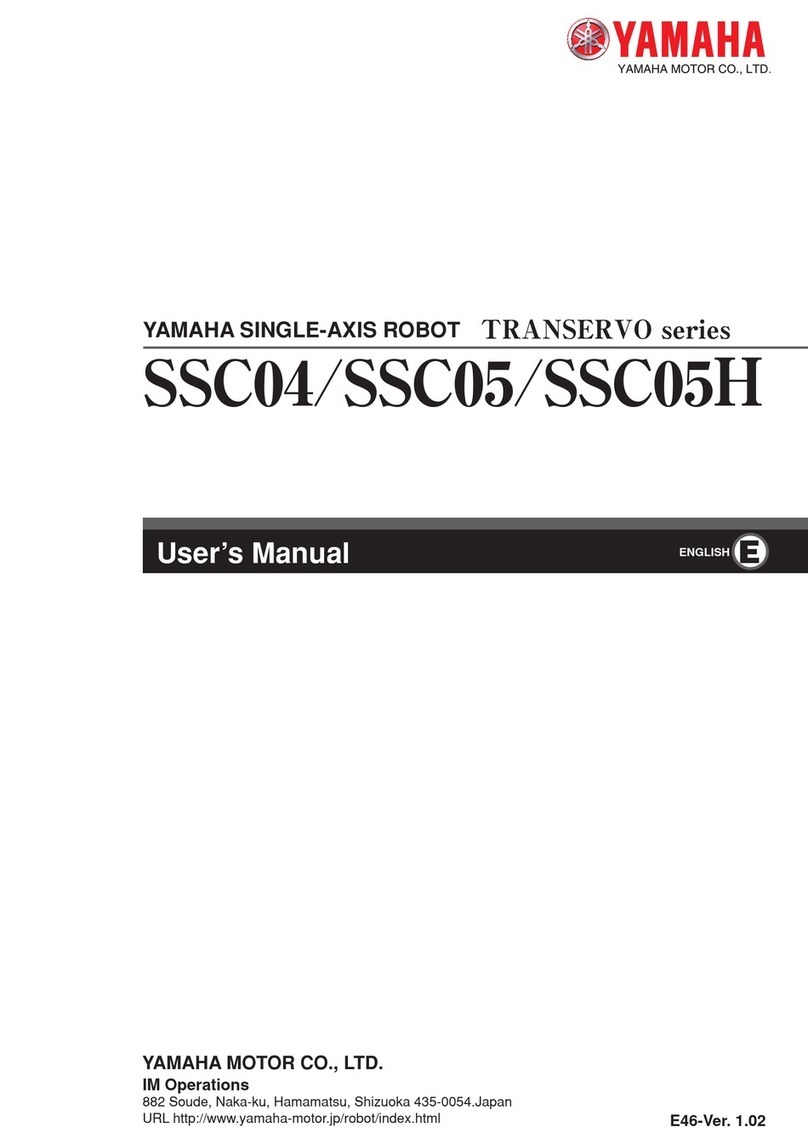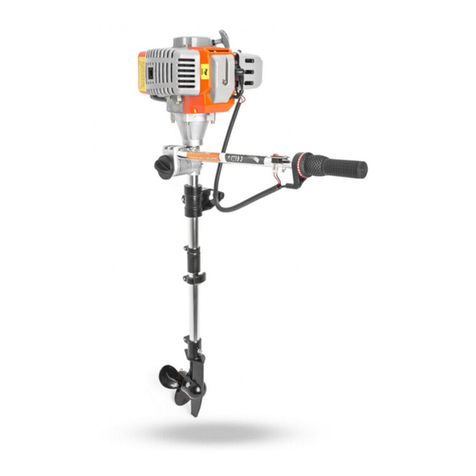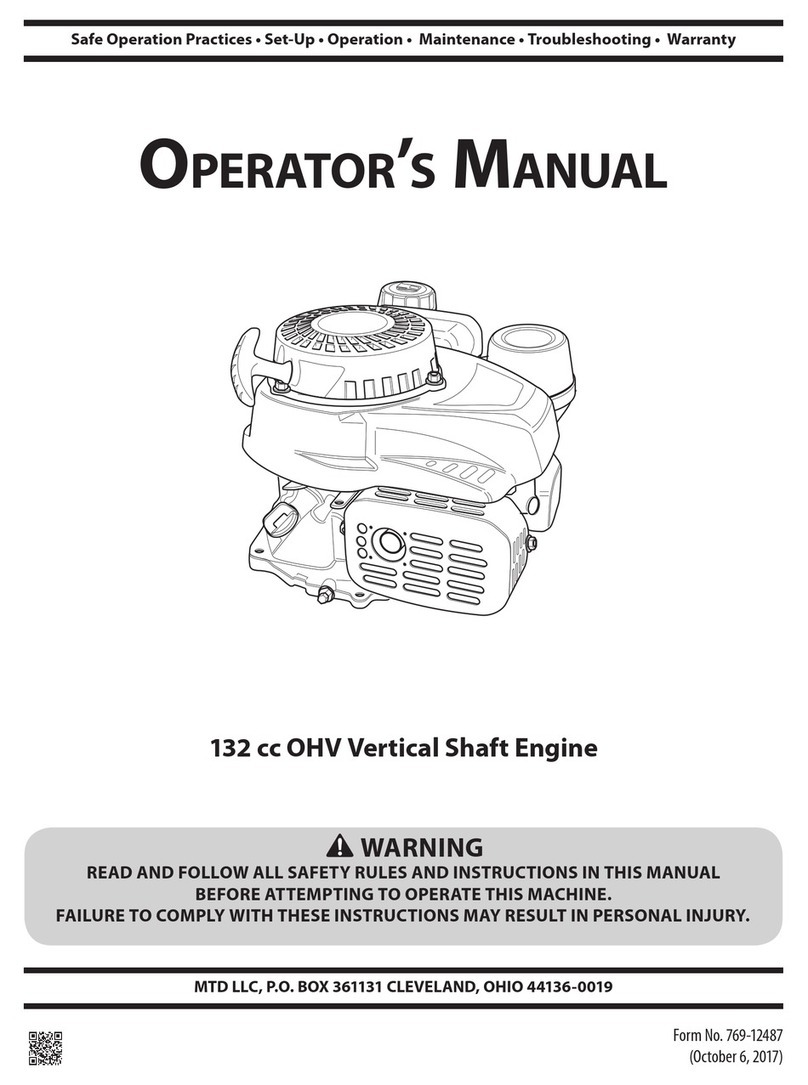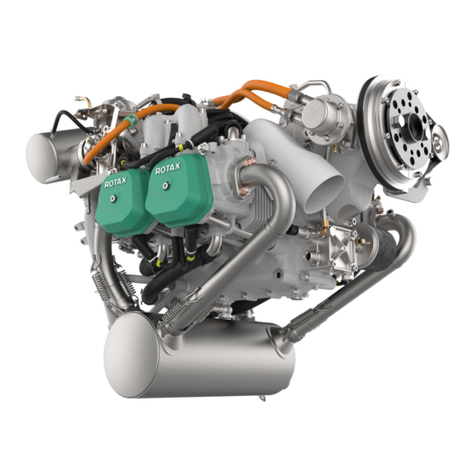Gaspar XICOY X Series User manual

Page 1
Xicoy TurboJet
Engines
User Manual
Version 1.4/2022

Page 2
Congratulations on your purchase of a new generation Xicoy “X” Series gas turbine engine. We are
confident you will be pleased with your purchase and your new engine will give you excellent ser-
vice and maximum enjoyment to your hobby.
“X” series engines are the result of a very extensive research and development programme by
Xicoy Electronica SL supported by the latest fluid dynamics and analysis software to bring you en-
gines of unparalled performance and incredible response in an amazingly small package. New elec-
tronics design and digital programming sets a new high bar standard for this new generation of
small jet engines.
Features:
Massive thrust in tiny industry beating case sizes
Low thrust
Low installed weight
Valves installed on-engine
ECU mounted on engine
Internal kero burner and thermocouple for clean exterior
Fast spool up to max rpm
Super-fast auto-restart with normal and glider modes
Automatic cooldown after run with receiver power turned off
Automatic power-off after cooldown
Brushless high speed starter
Intelligent brushless fuel pump
High speed digital control of all components
Neat slip-on FOD screen included as standard
Choice of display options, on and off board.
Telemetry options available for most modern transmitters
2
nd install kits available to swap engine between two airframes
New options are being added from time to time,
Keep watching on: www.xicoyturbines.com for details

Page 3
If you sell or pass on this engine to a 2nd or subsequent owner please also pass on this User’s
Manual or its link, so they can enjoy a safe and fulfilling ownership too.
The Xicoy Electronica SL responsibility is limited exclusively to the repair of the engine and acces-
sories which are outlined in the conditions of warranty.
Before unpacking the engine, please read through these notes and agree to the conditions of war-
ranty.
Customer satisfaction is important to Xicoy Electronica. Technical support is readily available
through your local dealer and via email:
Xicoy Electrónica SL, Plaça Pere Llauger Nau 18, 08360, Canet de Mar, Barcelona, Spain
Web site: www.xicoy.com Email: [email protected]
See our new turbine webpage at: www.xicoyturbines.com
Here is a contents list for this manual. Use ctrl-click to fast access any section.
Legal and Disclaimer ......................................................................................................................... 5
Disclaimer ............................................................................................................................................ 5
Warranty ............................................................................................................................................. 5
.............................................................................................................................................................. 6
Safety Notes ....................................................................................................................................... 7
General Notes ..................................................................................................................................... 8
Engine Specifications ....................................................................................................................... 10
Package Contents ............................................................................................................................ 11
ECU Battery ...................................................................................................................................... 11
Battery consumption ................................................................................................................... 11
Auto battery disconnect .............................................................................................................. 11
Fuel .................................................................................................................................................... 12
Engine Description ........................................................................................................................... 13
Component Description .................................................................................................................. 17
ECU (Engine Control Unit) ......................................................................................................... 17
Menu Items ................................................................................................................................... 17
Battery recognition ...................................................................................................................... 17
Kero/Diesel Selector .................................................................................................................... 18
Max thrust pre-set ....................................................................................................................... 18
Pump pre-set ................................................................................................................................ 18
Extended run recording .............................................................................................................. 18
Hub ................................................................................................................................................ 18

Page 4
Auto Power-Off............................................................................................................................. 19
Hub installed ambient sensors ............................................................................................... 19
Fuel Pump ......................................................................................................................................... 20
Construction.................................................................................................................................. 20
Pre-setting..................................................................................................................................... 21
ECU Display ...................................................................................................................................... 22
ECU data record / playback ....................................................................................................... 22
Plug-in backlit display.................................................................................................................. 23
Navigating Menu Screens ............................................................................................................... 24
Engine Installation: Electrical connections .................................................................................. 29
Shared ECU battery ..................................................................................................................... 29
Radio Setup .................................................................................................................................. 30
Aligning transmitter with ECU .................................................................................................... 31
Failsafe .............................................................................................................................................. 32
Preparing the engine for running .................................................................................................. 32
During start-up - general ............................................................................................................ 33
First engine run ............................................................................................................................ 33
Starting the engine .......................................................................................................................... 34
1st Run? ......................................................................................................................................... 34
Adjusting the engine maximum power. ................................................................................... 35
Engine shut down procedure ......................................................................................................... 35
Autorestart function ........................................................................................................................ 35
Restart Disclaimer ........................................................................................................................ 38
Throttle curves ................................................................................................................................. 38
Throttle stick position chart ....................................................................................................... 38
Acceleration and deceleration settings..................................................................................... 38
Diagnoses: ........................................................................................................................................ 40
Diagnosis messages: ................................................................................................................... 41
Telemetry:......................................................................................................................................... 41

Page 5
Legal and Disclaimer
The engine design and contents of this User Manual are copyright Xicoy Electronica SL, Canet de
Mar, Barcelona, Spain. All rights are reserved.
This User manual, pictures and data are the property of Xicoy Electronica SL and cannot be used
or reproduced in any way with written permission from Xicoy Electronica SL.
Disclaimer
This “X” Series engine is a very sophisticated piece of machinery. Great care should be taken at all
times when using the engine. It should only be operated by those with appropriate skills and
knowledge to do so. The engine is not a toy. Incorrect operation or misuse can cause damage to
property and bodily harm to operators, spectators or animals. Xicoy Electronica SL accepts no lia-
bility any damage which may occur.
Xicoy Electronica SL assumes no responsibility for any errors contained in this document and is not
liable for any damages resulting from such errors.
It is forbidden to use this engine outside radio control applications, especially those
that power vehicles to carry people.
Warranty
The warranty duration for this engine is two years from date of completed purchase, or 25
running hours, whichever comes first.
Warranty is valid solely for the original 1st owner and is non-transferable upon resale.
Warranty included all supplied parts and is limited to manufacturing defects only.
Shipment costs forth and back, including packing and relevant customs fees
are not cov-
ered
by the warranty, and will be at owner’s expense.
Damage or defective operation covered under warranty terms will be repaired and tested at no
cost to original owner (other than shipping expenses). Repairs not covered under the terms of
warranty will be carried out by Xicoy Electronica SL or their appointed agent after agreement of
costs.
Before
returning the engine or ancillary equipment for service or repair, please contact first your
local dealer or Xicoy Electronica SL central office to agree action and costs.
Do not ship before contacting Xicoy Electronica first
.. Shipping anything from outside
the EU without appropriate documentation will introduce significant delay and costs at
customs borders.
Please do not disassemble this engine or accessories (pump etc). You will breach your warranty
agreement and will find it an unfamiliar sophisticated and precision assembly which you may not
be able to reassemble without considerable difficulty and specialist equipment.

Page 6
Simply slackening the compressor nut on the engine will lose the delicate balance condition of ro-
tor without which the engine may not run without sustaining damage to the rotating assembly.
This warranty is voided if any one or more of the following conditions applies. In such a case Xicoy
Electronica SL will accept no responsibility for any damage or other consequence caused by engine
operation.
1. The product has been subject to any form of operation using incorrect fuel, oil or fuel/oil
mix.
2. The product is, or appears to be crash damaged, the fuel pump is blocked due to particle
ingestion, electronics or pump-drive are flooded with fuel or water ingress, connection leads are
cut or show loss of insulation and/or short circuit or reverse polarity on battery or engine cable
connection.
3. Unauthorized maintenance and/or modifications have been made to any part of the product;
including unlocking of the ECU and changing any of the manufacturers settings, or any items sup-
plied has or appears to have been disassembled.
4. Parts show damage by ingestion of foreign object (wires or pipes, sand, grit and small
abrasive particles, water or fluids, dry powder from extinguisher).
5. The engine has or appears to have been operated incorrectly or not in accordance to this
operators manual.
6. The product has been or appears to have been misused, neglected or inadequately main-
tained.
7. The engine or fuel pump has or appears to have suffered damage or blockages in the fuel
system due to being run with unfiltered or contaminated fuel.
8. The engine and/or accessories show damage by physical contact with a corrosive sub-
stance through operation or storage.

Page 7
Safety Notes
Please remember that though this engine is small it is most definitely NOT a toy and has the po-
tential to hurt you or others around you if misused. The engine is a very high performance ma-
chine in miniature and must always be treated with a high level of care and safety when in your
operation. It is your responsibility as owner, to ensure safe and considerate operation at all times
and conforming to the word and sprit of this User Manual. By running this engine you agree to
assume full responsibility for its safe operation.
The following guidelines should be read carefully and followed:
Always keep a C02 or similar gaseous fire extinguisher of at least 2kg contents close to
hand when starting and operating the engine. Do not use a powder extinguisher unless of last
resort as the powder will ruin the engine if it used.
Protect eyes and ears during the starting procedure.
Be especially aware this engine is very fast to start, initiate only when ready.
Please note this engine is extremely fast to spool to maximum thrust, use the throttle con-
trol carefully, especially with very small models.
Be aware of the extreme intake suction, use the available and supplied fod filter screen
always.
Always run the engine in open air as engine exhaust contains gases which can cause as-
phyxiation and nuisance smells.
The engine WILL be very hot while running, so please don´t touch it.
Keep clear anything affected by heat away from the engine, especially the exhaust area.
Don´t run the engine anywhere near a source of flammable gases, liquids or materials.
Don´t run the engine or fly the plane in wooded or crop or other high fire risk areas.
Keep spectators, children and animals clear of starting area (10mtrs (30ft) radius away).
Always handle turbine fuel and oil with care as they are flammable and can cause a reac-
tion with sensitive skin. Store them in clearly marked containers and always dispose appropriately.
Use protective gloves when mixing and decanting fuel and oils. Avoid all skin, eye, mouth or inges-
tion contact with the liquids and ensure any spillage is wiped up immediately. Clean any affected
area with warm soapy water. Wash hands and any effected part immediately after any contact.
Continued excess priming or failing of the starter burner can result in pooling of fuel inside
the engine which could cause excess flaming in event of subsequent ignition. The only method to
clear the engine is to tip it forward and allow excess to escape through the front of the engine.
Mop up with a rag. Tipping it backwards will not work as the internal construction of the engine
prevents any liquid draining out to the rear.

Page 8
General Notes
This engine is a real gas turbine machine with very high rotational speeds and high temperature
fast moving exhaust. Despite the small intake the engine is able to swallow a huge amount of air
and anything else that air can carry with it. So before running please carefully check the area sur-
rounding the front and back end of the engine for any loose materials like rags, sawdust, sand or
grit, modelling materials, liquids, or anything else that can be picked up by the airstream and
sucked into the engine, or blown out at speed by the exhaust.
If you are new to turbines or returning after some years it is a good idea to set up the engine on a
simple test stand so you can get familiar with its operation before installing it into a model. Use a
maximum thrust setting that is appropriate for your model especially on 1st flights. The RUN menu
shows this clearly, see “
derating
”. A power/weight ratio of 1:1 sounds great but can accelerate a
model dangerously quickly and can lead to control or structural failure of the model. If you have
recent jet engine experience you should be able to install the engine straight into your model but
take careful note of the quick response in start-up and throttling. Every engine is carefully test run
at the factory to ensure it performs properly, so you can take confidence to know it is fully opera-
tional at time of despatch.
Being an internal combustion engine the engine will consume oxygen during running so must nev-
er be run inside or in a confined space. The engine consumes a volume of air about 20ltrs/.74cu.ft
FOR EVERY KG OF THRUST every SECOND (ie, 4.5kg = a dustbin full) so can quickly use up a lot
of air in a limited space, so only run outside in open air. Never try to slow the engine by placing
any kind of restriction on the intake or the exhaust or on the model. The suction is more powerful
than any vacuum cleaner and can do severe damage to anything passing into the intake. It can
also collapse an airframe where insufficient area for the intake air is provided, or is restricted in
some way. The fod screen supplied is intended to prevent small articles being drawn into the en-
gine like blades of grass, small stones etc. It cannot prevent a rag or similar being accidentally
jammed against the front of the engine by the suction, so please take great care. Never test the
suction with fingers or hand, these engines bite hard.
The engine exhaust exit is small but with such a large volume of gas passing through it at pres-
sure it makes a loud penetrating noise. At a distance this noise is most pleasing but in close prox-
imity (within 5mtrs/16ft) the noise level can be very hazardous to hearing so always ensure you
and any nearby helpers have proper ear defenders and are wearing them while test running the
engine. Ensure you check carefully the area where you plan to run the engine and have someone
keep lookout for inquisitive bystanders who could approach to see the source of the noise, as you
will be concentrating on the engine. Agree a system of hand signals in advance so they know what
you are planning to do and can warn you of any issue during the run, i.e. shut down in a hurry or
reduce to idle if someone (or an animal) is approaching, walking by, etc.
The engine has its own internal starting system and does not require any assistance or priming to
operate. So please do not try to assist it to start quicker or easier by administering any flammable
agents, sprays or similar, into the engine in the belief it will start better. It won´t, but it could re-
sult in causing a dangerous flashback or fire to start which could rapidly get out of control and
putting yourself in danger or more surely the destruction of your model. The engine does not

Page 9
need priming like a petrol or glow engine to start, so when filling the fuel line for the first time
leave a couple of cm of empty pipe where it connects to the engine to be sure you have not
pushed a puddle of fuel into the engine which can cause a flame on start-up.
The engine is happiest operating with the cable connector upwards and the fuel inlet below. But if
it suits your installation better the engine can function safely rotated to suit your installation, but
you will find starting is quickest and easiest with the recommended positioning. If you find the
engine cable length is not sufficient for your installation, please do not cut it and try to extend it,
please get in touch with the Xicoy office for a longer version.
The engine has a replaceable internal starting glow plug. This is an Authorised Dealer and/or Ser-
vice Agent replaceable component as the engine must be opened to access it.
Note- unauthorised opening of the engine will void the warranty. The burner has been designed
that the rotor is not disturbed during this process so the balance is retained. The engine also fea-
tures an internal thermocouple. This avoids the danger to this delicate component being outside
the engine from the usual knocks and bumps associated with engine install and refit. If the ther-
mocouple needs attention please refer to nearest Service Agent or direct to Xicoy Electronica SL as
the engine case requires opening to access it.
The engine starter is a high quality high speed brushless unit. The power driver for this is part of
the ECU. It should go without saying you cannot replace this with anything else. You also cannot
power the starter separately beyond using the “starter test” function. The starter is accessible and
in the unlikely event of attention can be easily replaced. The small clutch fitted to the starter mo-
tor has a small O-ring which may wear in service. It is easily replaced if required.
Please note that the accessories used for this engine use the simple 3-wire servo type cable con-
nection. This includes the fuel pump, display, sensors, telemetry adapters etc. In all cases the third
wire (usually orange or white) is a digital signal line so DC power should not be applied to this line
or attempts made to read the voltage on this line for fault-finding purposes.
Please refer to the Xicoy office for guidance in the first instance in event of any issue.

Page 10
Engine Specifications
X45
X85/
X90
X120
X1
8
0
Engine diameter
60mm / 2.35”
7
6
mm / 3”
90mm / 3
-
1/2”
106
mm /
4
-
1/
8
”
Length
160mm / 6.3”
183mm / 7.2”
198mm / 7.8”
247
mm /
9
.8”
Engine weight
398g / 14oz
70
6
g / 1.6Lb
9
4
0g / 2.1Lb
1400
g /
3
.1Lb
Total installed weight
470g / 16.5oz
8
88
g / 1.8Lb
1
1
4
0
g / 2.
5
Lb
1
600
g /
3
.
5
Lb
Adjustable thrust range
at sea level
25
-
45N
5.5-10lbs
45
-
85/
90N
10-19,1/20lbs
60
-
120N
13.5-26.5lbs
100
-
1
8
0N
22-40.4lbs
Idle thrust
1.9N / 0.4lbs
3.3N / 0.7lbs
4
.3
N / 0.9Lb
4
.8
N /
1
.
1
Lb
Max rpm
225k
176k
150k
1
22
k
Min.
rpm
60k
48k
40k
28
k
EGT at max thrust
550
-
700´C
550
-
700´C
550
-
700´C
550
-
700´C
Fuel consumption at
max thrust
140g/min
–
4.7oz/min
265/
280g/min
–
9.95oz/min
350g/min
–
12.3oz/min
4
7
0
g/min
–
1
6o
z/min
Minimum exhaust tube
diameter
50mm / 2”
55mm / 2.2”
60mm / 2.4”
75
mm /
3
”
Battery recommended
Recommended
2S LiPo
3S LiFe can be used if 2s Lipo not possible.
Recommended 3s Lipo
3S LiFe can be used if
Lipo not possible.
Restart capable
manual (glider)
& automatic
Fuel / Oil
Kerosene + 4% oil mix.
Kerosene
(recommended)
or diesel + 4% oil mix.

Page 11
Package Contents
Engine unit inc. fod screen
Fuel pump
Hub Lite + colour display + 300mm signal cable, OR / Compact Hub
Engine cable 450mm
Battery cable
Servo type cable 300mm x 1
Fuel filter
4mm tubing, 1mtr (also 0,6mtr of 6mm fuel tube, X120 -X180 only)
Instruction card USB
ECU Battery
The engines have been designed to use a Lipo battery for power and all factory tests on all en-
gines are performed using this type of battery.
3S LiFe batteries are allowed in the case that Lipo can’t be used, but if possible use Lipo. Using a
higher battery voltage than 12V will damage the ECU.
Use at least 25C batteries, there is no upper limit. Do not use other battery types like LiIon, these
batteries cannot deliver the peak amperage (20-30A) necessary for starting.
Battery consumption
As example in mAh battery use, on average the X45 engine uses:
Start-up: 100mAh for X45
About 20mAh -30mAh for each minute running (depends on throttle position).
About 40mAh for cooling after a run.
A typical eight minute flight consisting of a start, normal flight and shutdown will consume:
100+(8x20)+40 = 300mAh
For the X85/X90 these values should be approximately x1.2, for the X120 approximately x1.4 and
for the X180, x 1.2.
Be sure to always disconnect the battery for charging. Some chargers use a high voltage pulse
system which can destroy the ECU.
Auto battery disconnect
The receiver may be turned off as soon as the aircraft is retrieved from flight, the Hub unit will
ensure the cooldown continues until the end. The Hub will then disconnect the battery after the
end of the cooldown.

Page 12
When the receiver is turned back on, the Hub unit will reconnect the battery. At the end of the
flying day it is good practice to disconnect the ECU battery as safety measure because the ecu use
a very small amount of current that can drain a 2000mAH battery in 1-2 month.
Fuel
The engines can be run using Kerosene or Diesel fuel. Kerosene is the recommended fuel if avail-
able; it produces the best user experience as the engine starts and accelerates faster, without
smoke, flames or unpleasant smell.
Diesel fuel is acceptable for most of the engines. The engine will not be damaged by using it, but
user experience will be worse, the operation will generate more flames, smoke, slower start up
and acceleration, odour, and can drip few drops of fuel out of the exhaust during startup. Power
is the same using both fuels.
Recommended Kerosene fuel is the odourless refined Kerosene (some countries call it ”Paraffin”)
used in home stoves, there are different commercial brands like “keroclair”, “Ptx200”, “Petroleum”
as it is very clean and burns without smell. JetA1 will work the same but should be carefully fil-
tered before use, but its odour can be offensive during model storage.
Use the fuel preset in the START menu to select your fuel: Kero / Diesel. The ECU automatically
adjusts start settings for each fuel.
Oil
The engine requires oil for lubricating bearings. This should be mixed at 4% with the fuel and all
lubricating is then automatically metered and applied by the engine internal components.
If you use a 20ltr fuel bottle then add 0.8l of oil. For every 3 gallons of fuel add 1 pint of oil.
Some DTE oils work well in operation but leave very little slippery residue which can cause the
bearings to sound dried out after cooling. In this case we recommend the addition of 1% percent
of 100% synthetic 2 cycle oil to the 3% DTE.
To check this, simply put one drop of DTE oil between finger and thumb and rub together. You
find DTE type oils rub through very easily, whereas 2 cycle oils stay slippery very much longer.
The opposite problem exists where exclusive use of 2 cycle oil is used as it thickens up on cooling
and can cause such drag on bearings the starter cannot turn the engine for a start. So we recom-
mend a part % oil mix as follows:
The required total amount is 4% of oil to be mixed with the fuel.
The recommended mix is a 3% of ISO32 type of oil, (commercial brands like Mobil DTE Lite,
Shell Tellus 32, Igol 32, Cepsa Turbine 32, etc)
plus 1% of 100% synthetic 2 stroke oil
. Plenty of
commercial brands 2T oil are available locally, just check in the bottle that the oil is JASO FC or
JASO FD compliant.

Page 13
Recommended commercial oil is Deluxe Power Model Jet Oil.
Other commercial turbine oils like Kingtech oil, Fuchs… can be used.
Don’t use Jetcat oil or Jackadofsky oil on the X45. These cause a lot of bearing drag when
cold causing difficult or impossible start-up.
It is allowed to use a 5% of oil contents for compatibility with other engine brands; this will
cause a higher fuel consumption and increased possibility of internal carbon building. Use 4% for
X45 if not using the recommended oil.
Full size turbine oils can be used, but are not recommended because these oils are not in-
tended to be burned; they are irritant and contain neurotoxic chemicals such as tricresyl phos-
phate that in long term could impact negatively on the health of operators and other persons
breathing the exhaust fumes.
Aeroshell 500 should not be used at all due to high residues left on bearings.
Do not use 2 stroke oil alone (4%). This will gum the bearings causing difficult or impossi-
ble start-up when engine is cold.
Please refer to the Xicoy Office for guidance in the first instance in event of any issue or concern.
Engine Description
The X series engines are miniature turbojets designed and produced specifically to produce thrust
to power small model aircraft. Each has a single stage billet machined centrifugal compressor and
single stage cast Inconel axial flow turbine mounted on a single shaft. The engine is fitted with a
long life ceramic glowplug which enables the engine to initiate combustion directly on liquid fuel
after which further fuel is gradually introduced into the main part of the combustion chamber to
provide combustion heat to operate the engine. A high speed brushless electric starter motor fitted
with a clutch mechanism to the front provides drive to the rotor up to and beyond self-sustaining
speed for starting the engine. The starting sequence is controlled by an electronic system fitted to
the engine (ECU) which initiates the start sequence and controls the parameters of the engine
within design limits.
The engine rotor shaft is supported by two ceramic bearings which are lubricated by a small per-
centage bleed off the pressurized main fuel supply, which should contain a small percentage of oil
for this purpose. The rotor discs are separately balanced and then 2-stage dynamically balanced
on assembly to the engine. Disturbing the rotor will lose this delicate balance and the engine will
need to be returned to a service unit for rebalancing.
The fuel for the engine is provided from a fuel tank and fed through a small pump driven by a 3-
phase (brushless) motor that has its own intelligent control. Each engine has its own dedicated
pump type and may not be mixed.

Page 14
The engine speed between idle and maximum is controlled by varying the speed of the fuel pump
rotor by command from the electronic device called an ECU (Electronic Control Unit) that is
mounted under the front cover of the engine. This sends commands to the fuel pump via a con-
nector board (Hub) to turn at a certain rpm (and therefore flow rate) to deliver a precise amount
of fuel and the fuel pump automatically adjusts itself to this rate. If the incorrect pump is fitted the
ECU will identify this and will not proceed, but display an error message.
The communication between the ECU and fuel pump and all other function accessories, display,
telemetry etc is via a single wire bidirectional digital data link, no analogue voltages are used and
operation is not voltage sensitive.
To control the admission of fuel to the burner and main combustion chamber there are two minia-
ture electric valves attached to a mounting block fitted to the front of the engine, under the cover.
This block also holds a 4mm quick-release fuel feed connection. The valves are connected to and
controlled by the ECU as required by the starting sequence. The valve block assembly is replacea-
ble but the individual valve assemblies are not user serviceable.
Installation Notes
1. The engine should be mounted securely using only the strap mount supplied.
2. The 3-wire connecting cable from the engine to the connector board should be carefully
routed away from the engine intake so there is no possibility of the wire being accidentally ingest-
ed if the FOD screen should be displaced for any reason. Avoid placing the cable close to the en-
gine rpm sensor which is located at approximately 4 O´clock when viewed at the front of the en-
gine with the cable entry plug at 12 O´clock. A cable too close can cause some rpm interference at
start-up. The same goes for any servo wires passing near.
3. The 4mm fuel feed pipe should be routed similarly clear of the intake.
4. The other end of the engine cable should plug into the Hub sited at a convenient location
for access. This is also the location to connect the ECU battery. If battery is sited at some distance
perhaps in the nose of the aircraft, please contact Xicoy and ask for a longer cable in one piece.
Please don´t cut it and splice in a couple of old bits of wire to make it longer. A heavy duty exten-
sion can be used but check polarity before plugging in. It’s always better to have a longer single
piece cable for minimum volt drop and maximum reliability.
5. The centre of the fuel tank should be located as close to the centre of gravity (CofG) of the
model as possible. This will minimize the effects of the CofG shifting as the fuel is used during the
flight. The fuel tank should have an effective fuel pickup, like a felt clunk or felt bag over a
weighted clunk to ensure no air is pulled into the fuel feed.

Page 15
6. The fuel pump should be located close to the fuel tank as convenient. Fit the inline filter
between tank and pump to protect the pump from particles that could jam the pump. The pump
has two screw fixings provided for mounting to the airframe.
7. If using “Tygon” flexible piping from fuel tank push on a short (12mm/1/2”) length of the
supplied 4mm pipe onto the pump suction port and push the “Tygon” over the top to provide a
tight leak free fitting. A double wrap of lock-wire will ensure secure connection
8.
DO NOT use nylon tie wraps anywhere on the fuel system.
9. DO NOT use “Tygon” flexible piping anywhere for the pressure (delivery) side; it is only
suitable on the suction side. Also DO NOT use silicon tube anywhere in the fuel system as the fuel
will melt it.
10. Any air ducting to the engine inlet should have sufficient diameter of at least the engine
case diameter.
11. If an extended exhaust duct (internal tailpipe) for internal installation is required, it should
be diameter as shown in the Specifications, and stiff enough to resist flattening in the airflow.
Leave a gap of 25mm (1”) from tip of the exhaust to the end of the duct (excluding bell mouth
length).
12. Extreme care should be taken to avoid the possibility of foreign objects, loose parts, dust or
debris being allowed to enter the compartment where the engine is installed. Always use the sup-
plied FOD screen but regard this as a last line of defence and not as a reason not to practice good
housekeeping. Before filling the tank and starting the engine for the first time, turn the model up-
side down and give it a good shake to loosen and clear any small bits and pieces lying in the en-
gine compartment. A go-around with the hoover is also a good idea.
13. We recommend testing the engine on a test stand prior to fitting to an airframe.
14. You should have a clear idea how to arrange all the components needed to run the engine
inside the model. The main issues are fuel tank (locate centre of tank to CofG), bubble trap posi-
tion (if used), locating the fuel pump in close proximity to the source of the fuel (bubble trap or
tank) and adjusting the receiver and ECU batteries to achieve optimum location for balancing the
model.
15.
Do not
under any circumstances try to run the fuel pump by plugging it into any other
FADEC brushless pump control or similar type 3-phase driver. It does not work like that and you
will destroy it in the process.
16. If you have two models you want to use the engine for, purchase a 2nd Installation Kit and
install all the components, pump, filter etc, as if it were a new install. You then only need to swap
the engine over between the models and the remaining installation is not disturbed, which gives

Page 16
the greatest flight security. The engine can accommodate any slight changes due to the installa-
tion. Don´t forget to blank off and cover the end of the fuel feed pipe to keep it clean.

Page 17
Component Description
ECU (Engine Control Unit)
The ECU and indeed the whole system used on these engines are totally new and unlike any pre-
vious version of Xicoy ECU. It is a new controller developed specifically for this application by Xicoy
Electronica which is in the form of a small C-shaped pcb fitted under the front cover of the engine.
It is connected via the 3-wire cable which plugs into the engine and to a small connector board
called the “Hub” externally which forms the connection to the outside world. The three wires are
just plus (+) minus (–) and data. The signals in and out of the ECU are via bidirectional digital
data link, no direct connection is required, or possible.
The ECU is a powerful new design using a completely new architecture than used before, so rep-
resents not an upgraded version of anything before but a new system completely. This new plat-
form allows us to break from the limitations of older technologies to make use of the latest high
speed connectivity to add many more functions than were possible before, and all using a single
wire data cable. All signals in and out of the ECU go via the Hub which acts as a clearing house for
ECU data and the outside world.
The ECU is programmed specifically for each engine with the engine operating characteristics, start
parameters, throttle curves and operating routines. Some of these are user settable like the radio
setup and maximum thrust settings which are accessed used via a menu system on a special data
display which plugs into the Hub or is part of the Hub itself. The ECU also controls the power to
operate the two valves, the brushless starter motor and the glow plug. Two of the three wires in
the 3-cable are the power for these.
Menu Items
Users familiar with other Xicoy ECUs will notice the menu structure is very similar to previous gen-
eration ECUs, but with some display items in new positions, some extra functions added and some
removed. This is mainly because the ECU is specially produced for the “X” Series so functions
which have previously been general purpose are now tuned specifically for the engine and fixed.
Anything which could be preset or does not require adjusting has been removed from access to
shorten the menus as much as possible to declutter.
Auto battery recognition
Kero / Diesel selector
Max thrust preset
Pump preset
Extended run storing
Battery recognition
Another addition is automatic detection and accommodation for LiPo and 9.9v 3-cell LiFe batteries.
The ECU detects the battery voltage at plug in, and automatically adjusts all the parameters to
work with the voltage supplied.

Page 18
Kero/Diesel Selector
The kero/diesel option which switches between preset routines for each fuel. This saves you the
ordeal of having to make many adjustments to fine tune the starting every time you switch fuels,
now you just press a button to click your fuel, and go. Diesel being heavier and higher flashpoint
fuel than kerosene requires a different start technique to enable it to start quickly and cleanly. We
have spent time optimizing the engine for each fuel and have prepared two start routines. You
choose the fuel option at the beginning of the START Menu and leave the ECU to use its pre-set
start routine. We recommend increasing the idle RPM to get better acceleration when using diesel
fuel.
Max thrust pre-set
To pre-set the engine to a reduced maximum rating there is a simple setting in the RUN menu
which shows maximum rpm with a corresponding nominal thrust figure. So it is easy to dial in a
certain thrust without having to know the rpm setting for this. This adjustment is operative be-
tween around half power and maximum. It can be adjusted while the engine is running.
Pump pre-set
A new engine package will have the fuel pump setting already set. In event of the pump needing
replacement for any reason the user can set the new pump to the default setting (75) and see the
heating effect on the engine on a start. If slow to heat up then the value can be raised to the next
level (100) which should be sufficient. If the flow is too high, perhaps the pump is very strong, it
may extinguish the ceramic element and make white smoke instead of proper ignition. In which
case the value can be lowered to 75 and the test repeated. Settings beyond these are not needed.
Once set, this value can be left and does not need adjusting in normal use unless swapping the
engine to a 2nd install. In this case it is a good idea to write on each pump the value used for the
best starting and when swapping the engine over to enter this value in the START menu. In prac-
tice we have found no adjustment needed from the default setting. All other start functions are
handled automatically by the ECU. There is no other fiddly tuning unlike in older kerostart systems.
Extended run recording
The heart of the ECU is one of the latest high speed microprocessors which enable it to carry out
millions of instructions per second and do a great many things at the same time without having to
stop and wait. It has its own memory so can hold programme instructions and operating data and
store runtime data from previous engine runs.
Hub
To enable connection of the power supply and signals to and from the outside world to the ECU, a
small connector board which we call the “Hub” is provided. This forms the connecting point for:
The receiver throttle signal (max voltage 10v)
ECU battery
Fuel pump

Page 19
ECU on the engine
Any display used, either on-board as part of the connector board, or separately plugged in
Additional input sensors such as pitot pressure, rpm from a 2nd stage, etc.
Additional output devices such as telemetry, SD memory storage, Bluetooth etc.
Auto Power-Off
The Hub has some intelligence of its own in that it can take a signal from the ECU and isolate
(power down) the ECU battery after a cooldown has completed and the receiver turned off. The
ECU will complete the cooldown process even if the receiver is turned off, it does not need a radio
signal to do this.
This saves the battery in the transmitter and receiver and helps stop the possibility of leaving them
on for long periods accidentally.
Hub installed ambient sensors
Hubs also have installed a pair of ambient sensors for temperature and pressure. These sensors
provide the ECU with data on ambient conditions which the ECU will use to pre-set certain function
parameters to take account of. These include the acceleration and deceleration ramps and idle
speed. In practice this means it is no longer needed for the User to provide any adjustment for
day to day ambient conditions as these are now taken care of by the ECU.
Where an “Auto” option in any menu is offered, the ECU will use the Hub data to adjust the setting
to the most appropriate for the conditions. To use this functionality the user simply leaves the pre-
set in the RUN Menu to Auto.
Hub location
Place the Hub unit in a location away from proximity with the exhaust or sunlight heating as oth-
erwise its ambient sensors will tell the ECU it is a hot day and moderate settings appropriately.
The Hub is available in several options, all with the sensors built in:
The simplest being the “Lite” option which is just a plain shrink
wrapped board to connect ECU battery, receiver, ECU, fuel
pump and a full colour external display.
The other option is called “Compact Hub” which is housed in a
small plastic box and has a black and white display and small
adjuster buttons, which you can mount in your model to elimi-
nate the need to plug in anything. The screen is very bright
making it easy to observe the start-up on the display from a
short distance through a canopy, for instance.

Page 20
Telemetry connectivity is possible using a dedicated module. The Xicoy website,
www.xicoyturbines.com will show what is available for the “X” Series engines at any time, new
items are being added regularly.
Hubs have a printed panel showing where each cable goes and the orientation of each plug. For all
cables, if you need a longer or shorter version than supplied, please contact Xicoy. Do not cut or
splice in extra wire.
Battery should be connected directly to the Hub, not using switches, electronic regulators, diodes
etc. Multiple battery operation using “Y” lead is possible but at least one battery must be directly
connected. If you are using the full colour plug-in display this is also plugged in here.
Fuel Pump
As mentioned previously, the fuel pump has
been specially designed for this application
and is unique in many ways. It is extremely
small in size and weight but is much more
sophisticated than its looks suggest. There is
not the usual fixed cable with socket but a
small plug built into the pump which enables
a regular high quality JR type servo cable to
be used as the pump cable (socket at both
ends). This way it’s easy to get just the right
length you need without cutting or extending the wire.
Each engine has its dedicated fuel pump. When powering up the ECU will recognise it and if you
try to use the wrong size pump you will get an error message and the engine will not allow a start.
Construction
Inside the sturdy machined aluminium housing is a powerful, purpose made brushless (3-phase)
motor with a ball raced (not plain bearing) shaft carrying a pair of precision close tolerance gears
to provide the displacement pump function. A pair of nipples provides a secure connection for pip-
ing at inlet and outlet. Two tapped holes in the body provide a secure mounting location avoiding
the need for tie-wraps and other messy fixings, for a neat and tidy installation. Never try to disas-
semble the pump, it has an extremely delicate internal structure and you will void its warranty.
Each engine variant has its own pump, you cannot mix and match.
Operation: The difference between this pump and most others is that it also has its own tiny
brushless 3-phase driver included within the pump housing. The motor is not a slave to an external
driver or an open loop dc motor driven by an external voltage, but has its own sophisticated con-
troller and driver built in. This controller communicates with the ECU via the Hub hundreds of
times a second and this includes the identifier to ensure it is the correct pump for the engine. The
ECU sends out a rpm request to the pump and receives actual rpm information and therefore flow
rate return signals back, and this process is updated continuously at high speed.
This manual suits for next models
8
Table of contents
Other Gaspar Engine manuals
